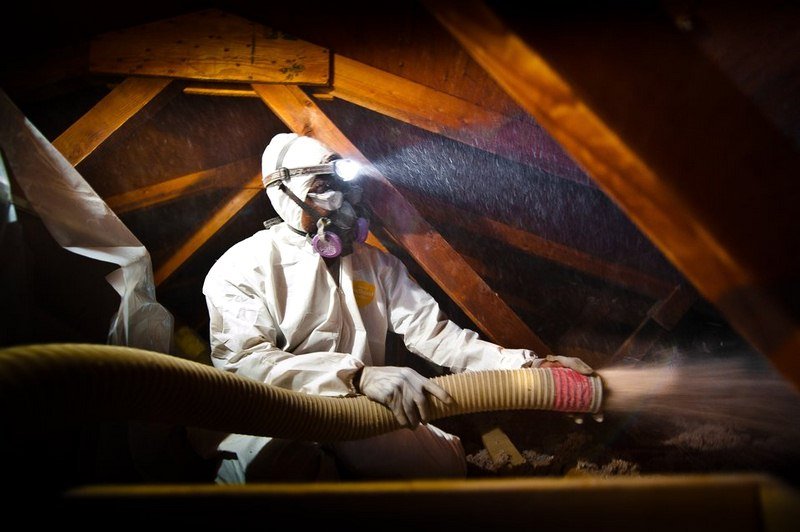Table of Contents Show
Insulation is one of the most valuable tools at a homeowner’s disposal for saving money year-round.
Understanding how insulation can save you money requires a quick overview of how heat moves and how insulation can take advantage of this movement in order to keep your home at a comfortable temperature, no matter what the season.

Read Also:
How Heat Moves
You might remember a bit about how heat moves from science class; here’s a quick refresher in case you don’t. There are three basic ways in which heat is transferred: radiation, conduction, and convection. You experience heat from radiation every day; the Sun heats the Earth through radiation.
Conduction occurs when hot particles come into contact with cold particles, transferring their heat and energy. When you put a spoon in your coffee and the handle of the spoon begins to heat up (even though it’s not in the coffee anymore), that’s conduction.
Convection refers to how heat moves through fluids – cool fluids are denser, and sink, while hotter fluids rise.
Notice that in all three types of heat transfer, heat is moving towards cooler substances. Cold particles are being bumped into by hot particles; the hot particles lose some energy and the cold ones gain some.
This continues until all the particles are at the same temperature. In the same way, convection occurs because dense particles fall and lighter particles rise; if they were the same temperature, they’d be the same density (assuming they’re the same type of particle), and movement would stop.
How Insulation Works
Based on the principles we illustrated above, we can understand the purpose of insulation: to stop heat transfer. When you’re stopping heat transfer, it always means you’re stopping a transfer of hot to cold. That’s why insulation works to your advantage at all times of the year.
When it’s cold outside, insulation stops the heat transfer from inside your house to outside your house. When it’s hot outside, insulation stops transfer from the heat outside to the inside of your house. By acting as a barrier to heat transfer, insulation works all year round.
When people discuss insulating their homes, it’s common to hear talk of attic insulation. Because heat rises, the attic is one of the easiest places for heat to escape from – unless it’s insulated. We suggest you insulate your entire home; any gaps will reduce the effectiveness of your insulation overall.
The Types of Insulation
There are a few different types of insulation and most are designed to reduce heat transfer through conduction and convection, though there are some radiant heat barriers that are available as well. You can classify insulation in two categories – materials and installation methods.
The materials used to insulate your home can vary greatly – you can get insulation that’s environmentally-conscious, that’s inexpensive, that’s noise-resistant; the list goes on. What most of these insulations have in common, however, is the way that they insulate.
We want to stop heat from leaving through convection; the movement of fluids we described earlier. That’s simple enough – we create a physical barrier. Convection only occurs through fluids, so if there’s something in the way, heat transfer is mitigated. We come across a second problem here, though: conduction.
The part of the wall outside your home may be colder or hotter than the part of the wall inside your home – that means heat transfer. We can stop that, however, with air pockets.
Air is (oddly enough) a very poor conductor of heat, so we suggest using insulation that has been made with millions of tiny air pockets – the air barrier will stop conduction and the physical barrier will stop convection. Whether you’re getting fibreglass, mineral, or any other type of insulation, this basic principle will apply.
Reflective insulation is a little different because it’s mainly focused on reducing radiant heat gain from the sun. That means it’s particularly effective at keeping your house cool in the summertime but not particularly useful for keeping your home warm in the winter.
The way that you’ll install your insulation can vary pretty widely depending on the build of your home. For hard-to-reach areas, spray-in (also known as loose-fill) insulation is often the way to go.
For areas you can access yourself, including some basements and attics, you can use blanket or batt insulation – one advantage of these is that you can install them yourself.
There are other types of insulation that are relatively specialized – rigid insulation, for example, is often used in air ducts because of its ability to withstand very high temperatures.
Conclusion
Most types of insulation will help keep your home warmer in the winter and cooler in the summer and thus reduces your need to heat or cool your home with your furnace or air conditioning.
In other words, properly insulating your home will lower your electric bill in the winter and summer. You may find it valuable to consult with a contractor who can assess heat transfer in your home.
They’ll be able to find the spots that need improved insulation. Remember, if there’s one weak spot in your home, it can drastically reduce the efficiency of your overall insulation setup.









